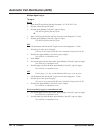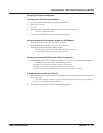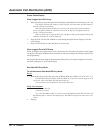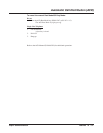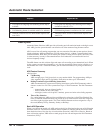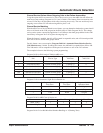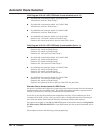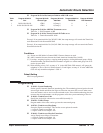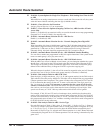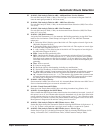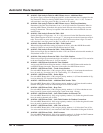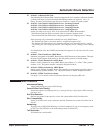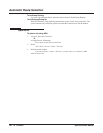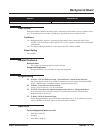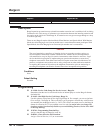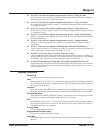
Automatic Route Selection
142 ◆ Features Aspire Software Manual
➻ 20-03-04 : System Options for Single Line Telephones - Dial Sending Start Time for SLT
or ARS
When ARS or an analog extension user accesses a trunk and dials an outside call, the system
waits this interval before outdialing the first digit (0-64800 seconds).
➻ 20-06-01 : Class of Service for Extensions
Assign a Class of Service (1-15) to an extension.
➻ 20-08-17 : Class of Service Options (Outgoing Call Service), ARS Override of Trunk
Access Map
Enable (1) or disable (0) an extension’s ability to override the trunk access map programming
(Program 14-07-01 and 15-06-01) for outgoing calls.
➻ 26-01-01 : Automatic Route Selection Service - ARS Service
Enable (1) or disable (0) ARS.
➻ 26-01-02 : Automatic Route Selection Service - Network Outgoing Inter-Digit ARS
Timer
With Networking, this timer (0-64800 msec.) replaces 20-03-04 when determining if all net-
work protocol digits have been received. If ARS is enabled at Site B, this timer can be pro-
grammed for 5 (500 msec) at Site A. If ARS is disabled and Site B is using F-Route for
outbound dialing, this timer should be programmed for 30 (3 seconds) at Site A.
➻ 26-01-03 : Automatic Route Selection Service - ARS Misdialed Number Handling
If a user dials a number not programmed in ARS, this option determines if the system should
route over trunk group 1 (0) or play error tone (1).
➻ 26-01-06 : Automatic Route Selection Service - ARS COS Match Access
With the ARS Class of Service Match Access feature, you can determine whether the system
should allow a call based on the COS assigned to the Dial Analysis Table (Program 26-02).
This change can be used to create a tenant-like application. It will then use the trunk group
defined in the Additional Entry in Program 26-02-03 to place the outgoing call.
When this feature is enabled (1), the calls will be routed in sequential order, and will forward
provided the Class of Service for the trunk groups match (0 = Disabled, 1=Enabled).
➻ 26-02-01 : Dial Analysis Table for ARS/LCR - Dial
Enter the digits (16 digits maximum: 1-9, 0 * #, @; 400 separate entries) for the Dial Analysis
Table which will be analyzed by ARS/LCR. This table will be checked after any programmed
F-Route operations have completed. The system will then refer to Program 26-02-02 and 26-
02-03 to determine the routing for the call. To enter a wild card/don’t care digit, press Line
Key 1 to enter an @ symbol. It is important to remember that the system checks the table
numbers in numerical order. This means that entries for specific numbers should be entered
first (such as your local area codes), then enter the items containing wild card digits. If the
system sees an entry of “2@@” then any table entries which follow will be ignored.
For example, if 268, 269, and 270 are local exchanges, these would be the first three table
entries which would route according to the settings made in Program 26-02-02 and 26-02-03
for each of the table entries. If the next entry is “2@@”, then the system checks no further in
this program and routes all other “2xx” numbers according to the entries made in Program 26-
02-02 and 26-02-03 for this table entry.
➻ 26-02-02 : Dial Analysis Table for ARS - Service Type
For each Dial Analysis Table (1-200), select ‘0’ for no ARS, ‘1’ for Service Type 1 - Route to
Trunk Group Number to have the number route to a trunk group [Refer to Program 26-02-03]
or ‘2’ for Service Type 2 - F-Route Selected to have the dialed number controlled by the F-
Route table. If Service Type 2 is selected and F-Route operation is on, the F-Route table used
is determined by Program 44-04. If F-Route operation is off, the routing is determined by Pro-
gram 44-05.



